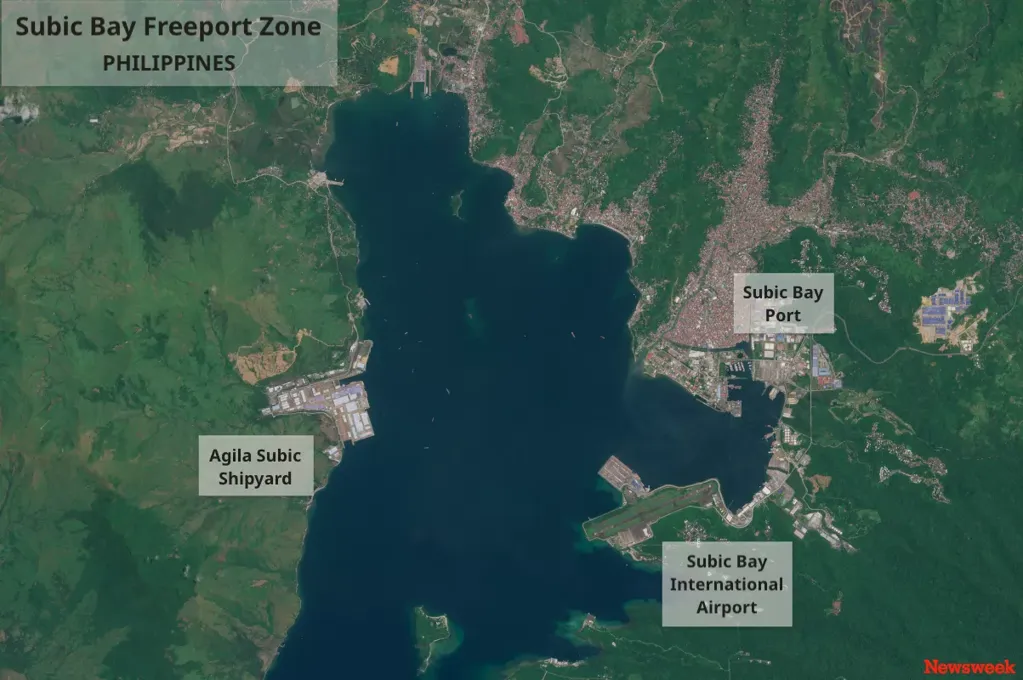A Philippine port once home to the United States Navy's largest overseas base is reemerging as a center of allied activity and shipbuilding.
At the center of the Freeport Zone's transformation is the Agila Subic shipyard, operated by Hyundai Heavy Industries. New investment from the U.S. and South Korea revives Subic Bay's strategic importance at a time of rising regional tensions with China.
Subic Bay's reopening as a shipyard and logistics hub comes more than three decades after the U.S. military withdrew from the base. The transformation, spurred by American and South Korean investment, as well as Philippine government support, signals a shift in regional security and a potential staging ground for allied forces as tensions simmer in the South China Sea.
The Philippines is locked in a long-running territorial dispute with China over China's expanding presence inside the U.S. defense treaty ally's exclusive economic zone.
Newsweek reached out to the Pentagon, Chinese Foreign Ministry, and Philippine Department of Foreign Affairs via email for comment.
The Agila Subic shipyard, now operated by Hyundai Heavy Industries, occupies a sprawling facility originally built by South Korea's Hanjin Heavy Industries, which went bankrupt in 2019 after operating as one of the largest shipbuilding centers in Southeast Asia.
After Hanjin's collapse, the yard became the focus of a high-profile bidding war between U.S. and Chinese interests, according to USNI News. American investment firm Cerberus Capital Management ultimately took control, outbidding Chinese competitors and paving the way for renewed U.S. and allied activity at Subic.
Since its revival, the shipyard has attracted a growing mix of tenants, including the Philippine Navy, U.S. defense firms, and maritime companies. Both commercial and naval shipbuilding are now central to its expansion plans.
Elsewhere in the Freeport Zone, U.S. and Philippine officials have greenlit a separate munitions plant. The project is being described as the world's largest weapons manufacturing hub, intended to boost Philippine self-reliance and U.S. regional readiness.
U.S. President Donald Trump has called the ammunition plant "very important," highlighting its value for both countries' defense needs. Philippine President Ferdinand Marcos Jr. has said the plant will support Manila's drive for a modern, self-sufficient military.
The Freeport Zone was created after the U.S. military left Subic Bay in 1992. In recent years, new projects have included not just shipbuilding but also a U.S. Marine Corps logistics hub.
MaryKay Carlson, U.S. ambassador to the Philippines, on X: "Shipbuilding is back at the Agila Subic Shipyard! Honored to join [Philippine] President Marcos South Korean] Ambassador Lee for the HD Hyundai steel cutting ceremony, highlighting Subic Bay's strategic role in the Luzon Economic Corridor."
Maritime analyst Brent Sadler, on X: "China was eyeing the port with bids to take over the [formerly Hanjin] yard. This would have been problematic for the U.S. and the Philippines security -- especially in sustaining naval presence pushing back on Chinese encroachment nearby in the South China Sea.
"The deal brokered in 2018 ensured that didn't happen. A case of naval statecraft leveraging economic levers."
President Donald Trump said of the ammunition plant following talks with Philippine counterpart Marcos in July: "It's very important. Otherwise, we wouldn't have approved it."
